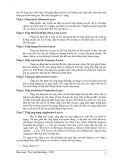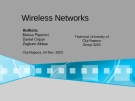
OSI Physical Layer
-
After completing this chapter, students will be able to: Explain the role of Physical layer protocols and services in supporting communication across data networks, describe the role of signals used to represent bits as a frame as the frame is transported across the local media, describe the purpose of Physical layer signaling and encoding as they are used in networks.
 87p
87p  youcanletgo_01
youcanletgo_01
 04-01-2016
04-01-2016
 70
70
 6
6
 Download
Download
-
The Data-over-Cable Service Interface Specification (DOCSIS)is an international standard developed by CableLabs, a non-profit research and development consortium for cable-related technologies. • DOCSIS specifies the OSI Layer 1 and Layer 2 requirements: Physical layer-For data signals that the cable operator can use, DOCSIS specifies the channel widths (bandwidths of each channel) as 200 kHz, 400 kHz, 800 kHz, 1.6 MHz, 3.2 MHz, and 6.4 MHz. DOCSIS also specifies modulation techniques (the way to use the RF signal to convey digital data).
 47p
47p  mrdvad11
mrdvad11
 12-03-2013
12-03-2013
 136
136
 54
54
 Download
Download
-
Ý nghĩa của việc phân tầng ? -Giảm độphức tạp -Chuẩn hóa các giao tiếp -Phùhợp với công nghệ modul -Đảm bảo sự thương thích vàkếthừa -Tạo động lực phát triển công nghệmạng -Đơn giản việc dạy vàhọc Tầng vật lý –Physical Layer: •Bao gồm các thiết bịvật lý thực hiện kết nối mạng: đường truyền, thiết bịkết nối, … •Cung cấp các phương tiện điện, cơ, chức năng, thủtục đểkích hoạt, duy trìvà đình chỉliên kết vật lý giữa các hệthống •Thực hiện truyền dẫn nhịphân, tín hiệu mạng giữa các hệthống truyền thông...
 20p
20p  hongphongit
hongphongit
 01-03-2013
01-03-2013
 122
122
 17
17
 Download
Download
-
Đợc phát triển bởi tổ chức tiêu chuẩn thế giới ISO (International Standard Organization) Gồm có 7 tầng: Tầng vật lý (Physical layer) . Tầng liên kết dữ liệu (Data link layer) Tầng mạng (Network layer) . Tầng vận chuyển (Transport layer) . Tầng giao dịch (Session layer) . Tầng trình bỡy (Presentation) . Tầng ứng dụng (Application layer) .
 13p
13p  nghiapro512
nghiapro512
 22-09-2012
22-09-2012
 132
132
 28
28
 Download
Download
-
Tương đương với tầng liên kết dữ liệu (data link layer) và tầng vật lý (physical layer) của mô hình OSI Nhiệm vụ : truyền dữ liệu tin cậy trên đường kết nối vật lý giữa các thiết bị
 6p
6p  ngoducquyet
ngoducquyet
 04-06-2012
04-06-2012
 115
115
 26
26
 Download
Download
-
. Đại Học Cần Thơ – Khoa Công Nghệ Thông Tin – Giáo Trình Thiết Kế & Cài Đặt Mạng – V1.0 nên dễ dàng hơn. Mô hình OSI giúp đồng nhất các hệ thống máy tính khác biệt nhau khi chúng trao đổi thông tin. Mô hình này gồm có 7 tầng: Tầng 1: Tầng vật ký (Physical Layer) Điều khiển việc truyền tải thật sự các bit trên đường truyền vật lý. Nó định nghĩa các thuộc tính về cơ, điện, qui định các loại đầu nối, ý nghĩa các pin trong đầu nối, qui định các mức điện thế...
 10p
10p  iphone5
iphone5
 25-10-2011
25-10-2011
 85
85
 4
4
 Download
Download
-
Mô hình OSI giúp đồng nhất các hệ thống máy tính khác biệt nhau khi chúng trao đổi thông tin. Mô hình này gồm có 7 tầng: Tầng 1: Tầng vật ký (Physical Layer) Điều khiển việc truyền tải thật sự các bit trên đường truyền vật lý. Nó định nghĩa các thuộc tính về cơ, điện, qui định các loại đầu nối, ý nghĩa các pin trong đầu nối, qui định các mức điện thế cho các bit 0,1
 5p
5p  phuoctam45
phuoctam45
 28-07-2011
28-07-2011
 82
82
 8
8
 Download
Download
-
This diagram illustrates the Physical layer (Layer 1) of the OSI model. The Physical layer is responsible for the ultimate transmission of data over network communications media. It operates with data in the form of bits that are sent from the Physical layer of the sending (source) device and received at the Physical layer of the destination device. Ethernet cabling, Token Ring network technology and SCSI all function at the Physical layer of the OSI model. Hubs and other repeaters are standard network devices that function at the Physical layer.
 54p
54p  thanhtq00103
thanhtq00103
 08-06-2011
08-06-2011
 115
115
 20
20
 Download
Download
-
The Data-Link layer is the protocol layer in a program that handles the moving of data in and out across a physical link in a network. The Data-Link layer is layer 2 in the Open Systems Interconnect (OSI) model for a set of telecommunication protocols.The Data-Link layer ensures that an initial connection has been set up, divides output data into data frames, and handles the acknowledgements from a receiver that the data arrived successfully. It also ensures that incoming data has been received successfully by analyzing bit patterns at special places in the frames....
 64p
64p  thanhtq00103
thanhtq00103
 08-06-2011
08-06-2011
 147
147
 14
14
 Download
Download
-
Explain the role of Physical layer protocols and services in supporting communication across data networks.
 50p
50p  asvenus
asvenus
 24-05-2011
24-05-2011
 106
106
 8
8
 Download
Download
-
Tầng 1: Tầng vật lý (Physical Layer) Tầng vật lý định nghĩa tất cả các đặc tả về điện và vật lý cho các thiết bị. Trong đó bao gồm bố trí của các chân cắm (pin), các hiệu điện thế, và các đặc tả về cáp nối (cable). Các thiết bị tầng vật lý bao gồm Hub, bộ lặp (repeater), thiết bị tiếp hợp mạng (network adapter) và thiết bị tiếp hợp kênh máy chủ (Host Bus Adapter)- (HBA dùng trong mạng lưu trữ (Storage Area Network)). Chức năng và dịch vụ căn bản được thực hiện bởi tầng vật...
 54p
54p  erjokoi
erjokoi
 22-07-2010
22-07-2010
 341
341
 134
134
 Download
Download
-
Explain the role of Physical layer protocols and services in supporting communication across data networks. – Describe the role of signals used to represent bits as a frame as the frame is transported across the local media Describe the purpose of Physical layer signaling and encoding as they are used in networks Identify the basic characteristics of copper, fiber and wireless network media Describe common uses of copper, fiber and wireless network media
 54p
54p  thangvu89
thangvu89
 15-04-2010
15-04-2010
 190
190
 36
36
 Download
Download
-
Wireless network refers to any type of computer network that is not connected by cables of any kind. It is a method by which homes, telecommunications networks and enterprise (business) installations avoid the costly process of introducing cables into a building, or as a connection between various equipment locations.[1] Wireless telecommunications networks are generally implemented and administered using a transmission system called radio waves. This implementation takes place at the physical level (layer) of the OSI model network structure....
 47p
47p  acxelopanh
acxelopanh
 01-12-2009
01-12-2009
 302
302
 161
161
 Download
Download
CHỦ ĐỀ BẠN MUỐN TÌM

























